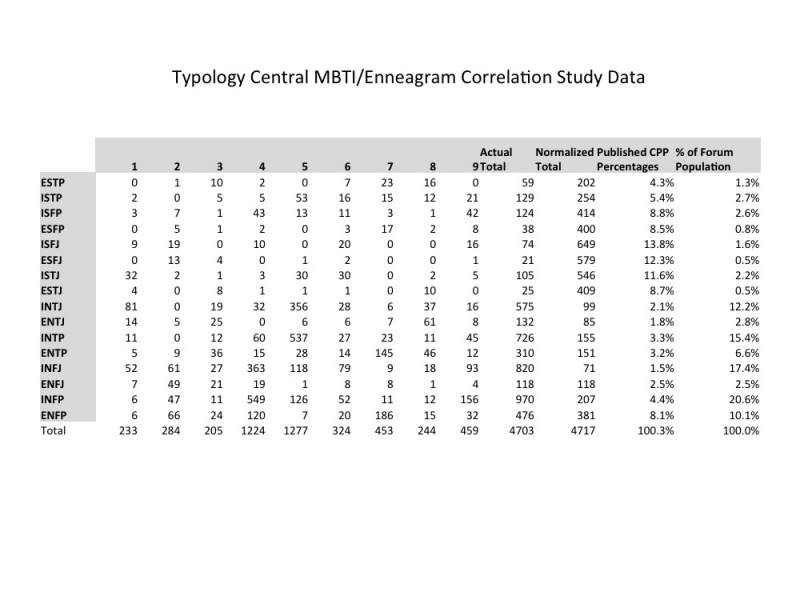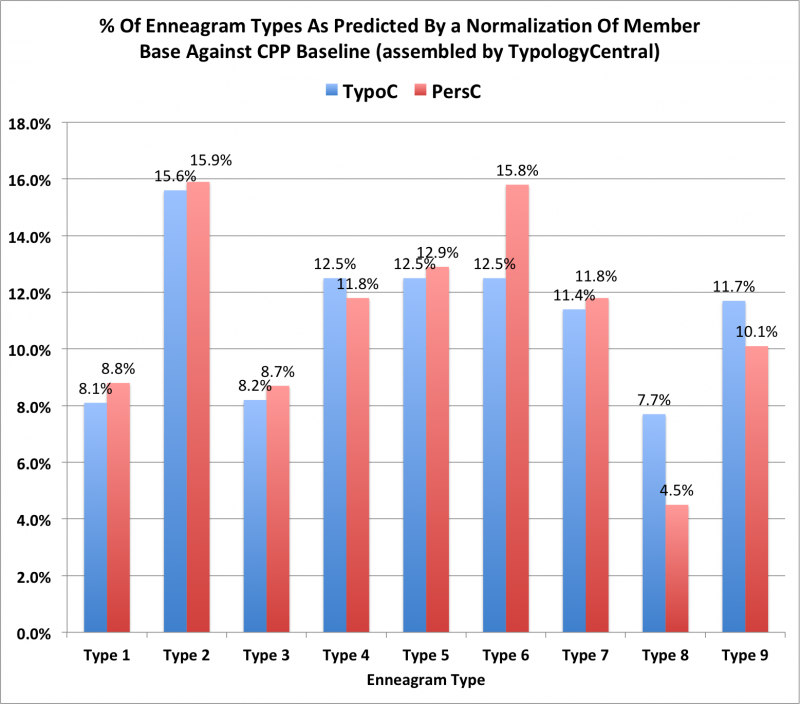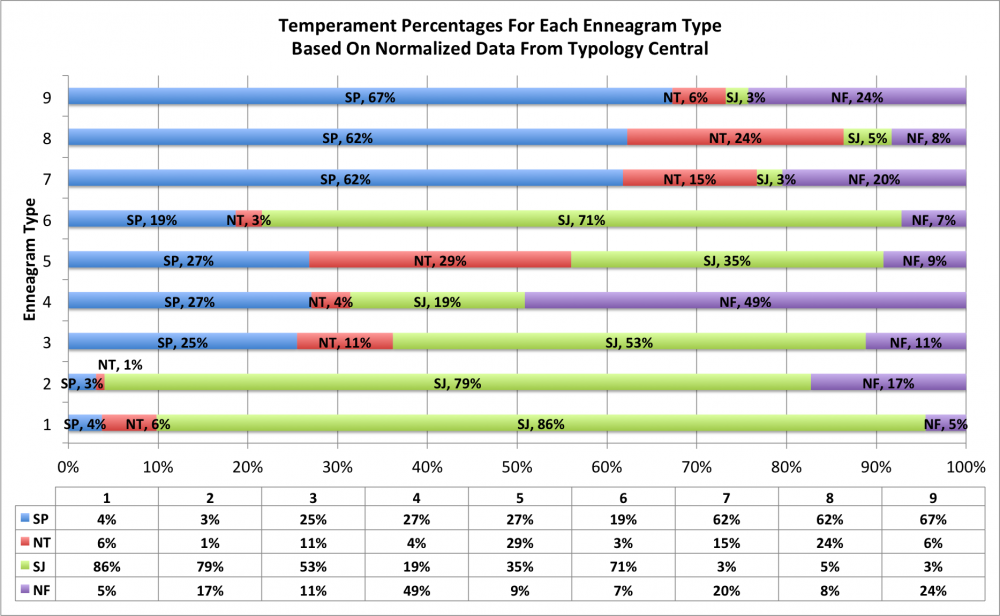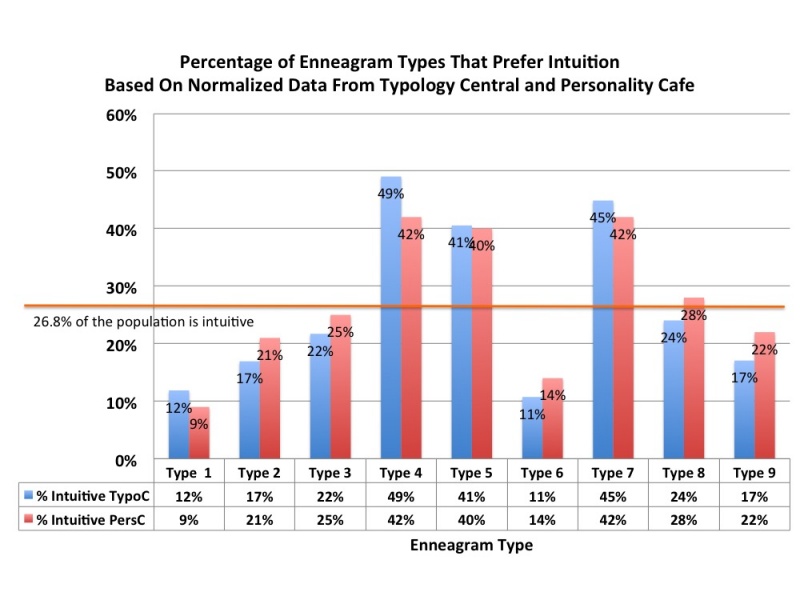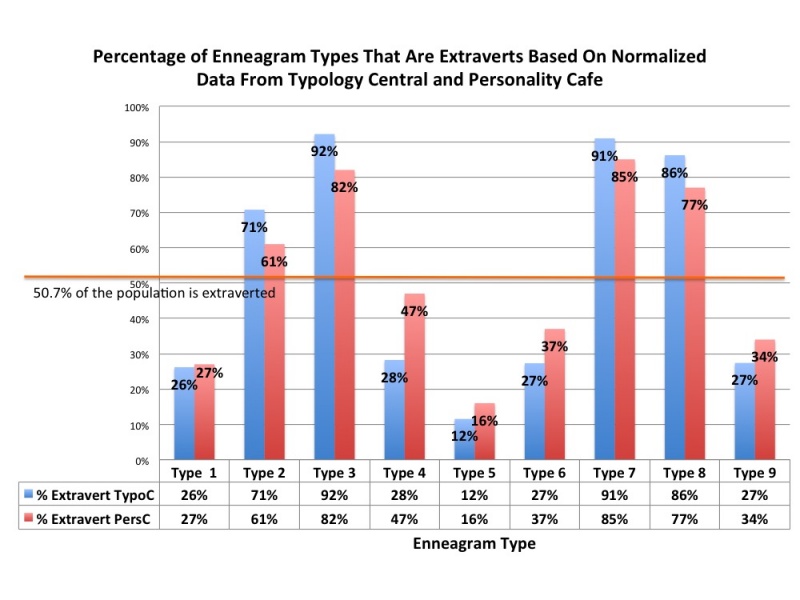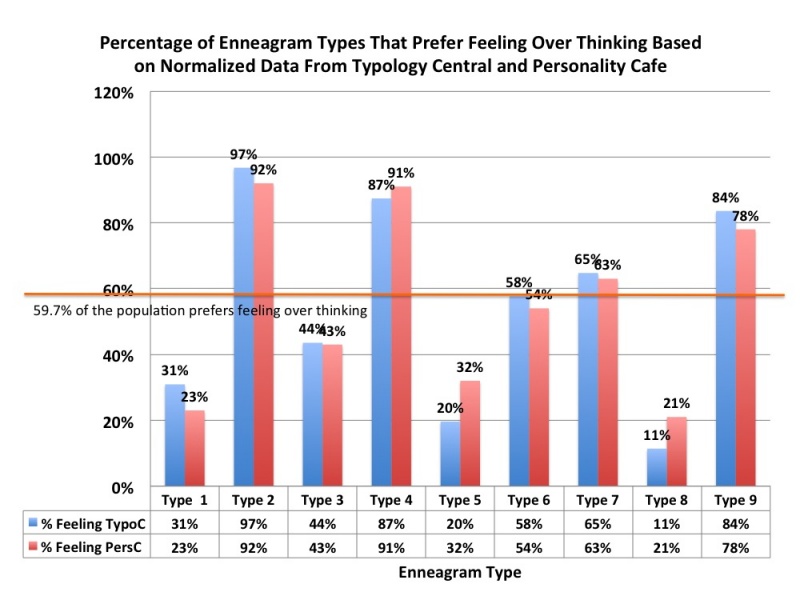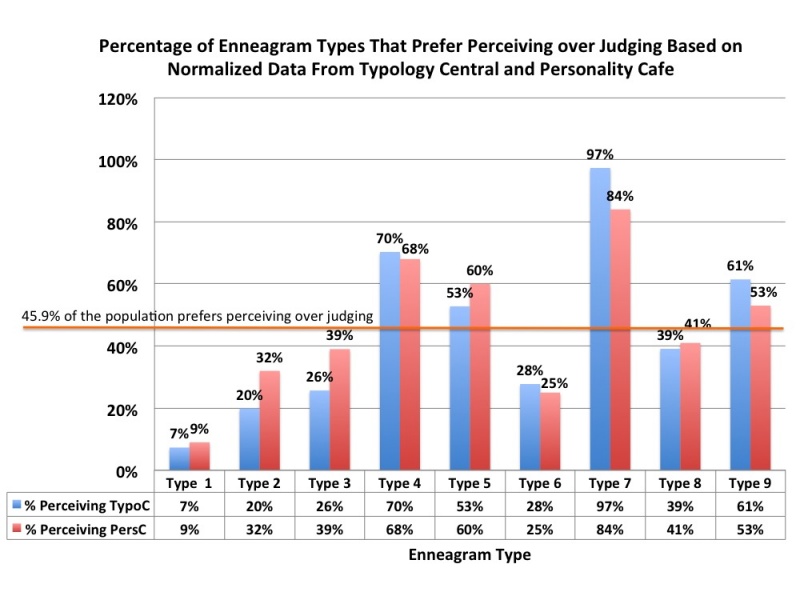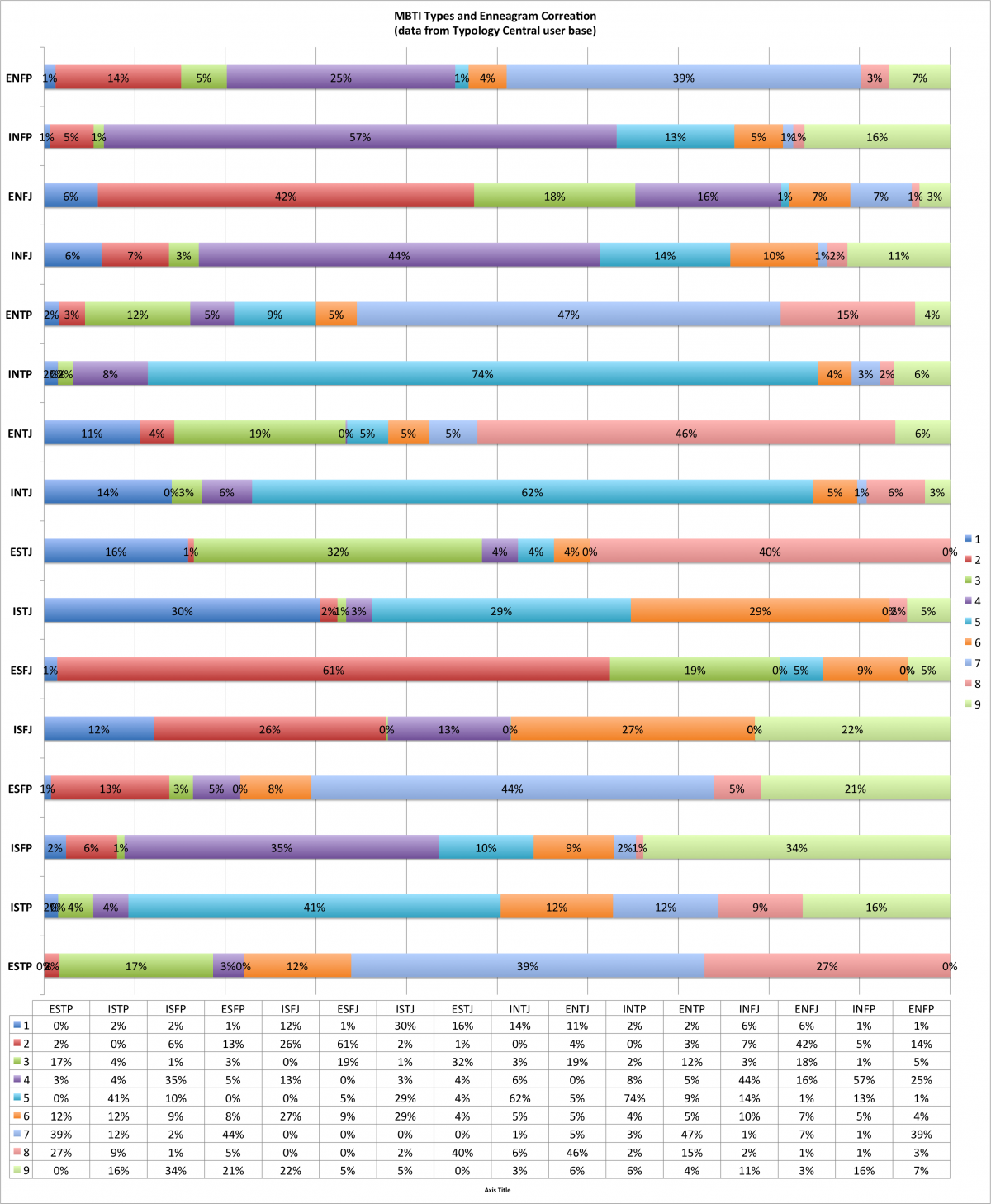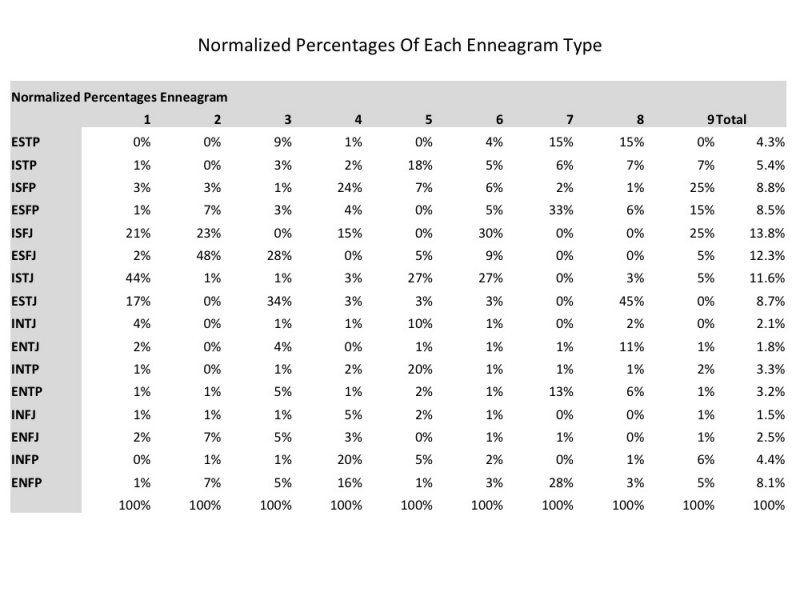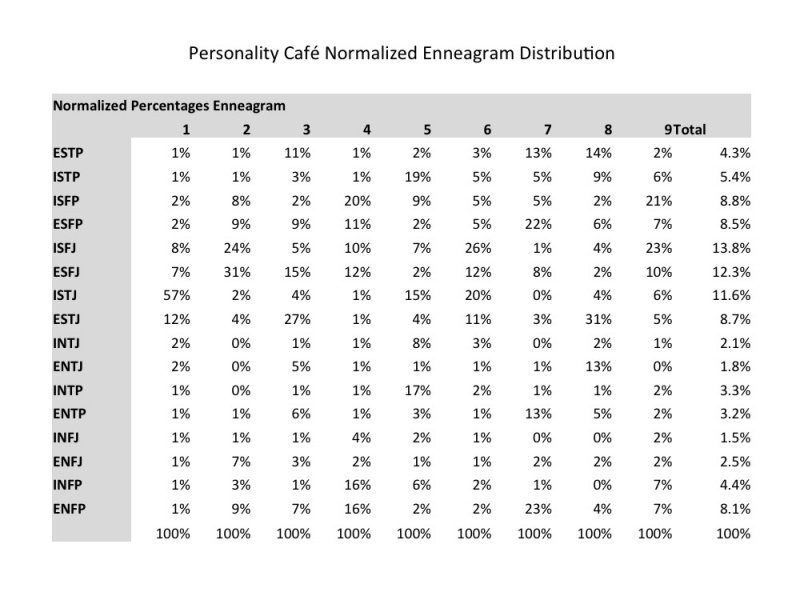Enneagram and MBTI Correlation
This study analyzed the relationship between Enneagram Type and MBTI Type using data from the TypologyCentral User Base and Personality Cafe User Base. The purpose was to understand several things:
- Is there a correlation between MBTI Types or underlying Cognitive Functions and Enneagram Types
- What is the frequency of Enneagram types within each of the 16 MBTI types
- What is the frequency of MBTI types within each of the 9 Enneagram Types
Study Methodology
Two sets of data were analyzed. The initial analysis was conducted using data from the Typology Central User Base which consisted of 22,877 members collected November 30, 2015. 4,703 of those members had entered in both their MBTI and Enneagram Type. The second data set of 21,105 members was from Personality Cafe, collected August 20, 2014. Raw data was utilized to capture the % of Enneagram types with each of the 16 types. Because the distribution of both Forums is disproportionately weighted towards Introverted Intuitives, the data was normalized using the published CPP MBTI percentages as a base - creating a set of numbers as it were, that would represent what the forum numbers would look like if they consisted of types aligned with the CPP distribution. Illustrative data for Typology Central and the normalized totals for each MBTI type are shown below.
Study Results
Frequency Of The Different Enneagram Types
Using normalized data across the two forums, it can be seen that the % of Enneagram types in the population was relatively consistent, with the exception of many more 8s vs 6s on Typology Central. Having at one point been mistyped as an 8 myself (I am a 6), I found this point to be particularly interesting, though it would be oversimplifying to attribute the difference in the two sets of data to that one potential mistype. The difference on this may be a combination of mistyping on one or both forums combined with herd behavior. One key point is that the Enneagram types are well represented across the population as a whole ranging from a low of about 6% to a high of 16%. This differs from the MBTI distribution which ranges from 1.5% INFJs to 13.8% ISFJs – making ISFJs nine times more common than INFJs. Enneagram doesn’t appear to have such wide variations in frequency across the various types.
Percentages of MBTI Types Within Each Enneagram Type
What types do we most think of for each of the Enneagram Types? Our answer is probably the following:
- Enneagram Type 1 - ISTJ
- Enneagram Type 2 - ESFJ
- Enneagram Type 3 - ESTJ
- Enneagram Type 4 - INFP
- Enneagram Type 5 - INTP
- Enneagram Type 6 - ISXJ
- Enneagram Type 7 - ENXP
- Enneagram Type 8 - EXTJ
- Enneagram Type 9 - ISFP
Why do we think that? Here's why. Though any mapping MBTI to Enneagram type is potentially feasible, there are very significant correlations between MBTI Personality Type and Enneagram Type. The following graphic, which shows the Temperament makeup for each of the Enneagram types, clearly illustrates this.
Several overall themes and patterns emerged from the data.
- Enneagram 1 - There is a strong correlation between Enneagram 1 and those that prefer Introverted Sensing in the dominant or auxiliary position. There was also a correlation between Enneagram 1 and Introversion. 82% - 84% of Enneagram ones are of four types: ISTJ, ESTJ, ISFJ and ESFJ. Reflecting the the higher frequency of 1 among sensors and higher percentage of sensors in the population as a whole, it can be observed that 88% - 90% of Enneagram 1s are Sensors, with INTJs and ENTJs being the Intuitive types mostly likely to be a 1.
- Enneagram 2 - 93% - 98% of Enneagram 2s have a preference for Feeling over Thinking. There appears to be a specific additional correlation between Enneagram 2 and Extraverted Feeling. 63% - 79% of Enneagram 2s fall into four types: ISFJ, ESFJ, ENFJ and INFJ. Enneagram 2 is especially prevalent amongst those that have a dominant preference for Extraverted Feeling - specifically ENFJs and ESFJs, where it is by far the most common Enneagram type.
- Enneagram 3 - Between 82% and 91% of Enneagram 3s are Extraverts and this single dimension appears to be the most strongly correlated with the type, 62% -74% of 3s fell into four types: ESTJ, ESFJ, ESTP and ESFP. Intuitive types that were mostly likely to be an Enneagram 3 were ENTJ, ENTP and ENFJ.
- Enneagram 4 - Enneagram 4 is strongly correlated with a preference for intuition as well as feeling. It is also more likely to be associated with introversion than extraversion. The types most likely to be Enneagram 4 are in order of likelihood, INFP (42% - 57% of INFPs are 4), INFJ (29% - 44% of INFJs are 4), ISFP (27% - 35% of ISFPs are 4) and ENFP (23% - 25% of ENFPs are 4). Between 56% and 65% of Enneagram 4s are made up of these three types. An additional 19 - 31% of Enneagram 4s are ISFJs and ESFPs because it is not an uncommon type for them and their overall prevalence in the population as a whole.
- Enneagram 5 - Though almost any type could be a 5, Enneagram 5s are typically Introverted Thinkers with 59% to 75% falling into one of four types INTP, ISTJ, INTJ, and ISTP. It is by far the most common type for INTPs, INTJs and ISTPs.
- Enneagram 6 - Enneagram 6 is interesting in that it is present in significant numbers across all of the MBTI types. 13% - 17% of Sensing types and 6% - 10% of Intuitive types were Enneagram 6 making it more strongly correlated with Sensing than Intuition. Reflecting the the higher frequency of 6 among sensors and higher percentage of sensors in the population as a whole, it can be observed that 87% - 89% of Enneagram 6s are Sensors. There was an especially strong correlation specifically between Enneagram 6 and the SJ Temperament. ISTJs and ISFJs are the two types that are most likely to be Enneagram 6 and these two types alone constitute 46% - 57% of the Enneagram 6s in the overall population.
- Enneagram 7 - Enneagram 7 correlates strongly with EP - dominant Extraverted Intuition (ENFP, ENTP) and dominant Extraverted Sensing (ESFP, ESTP). 71% - 89% of Enneagram 7s were one of those four types.
- Enneagram 8 - 8 is by far the most common Enneagram type for ENTJs, representing 32% - 46% of the population. 58% - 71% of Enneagram 8s fell into one of three types: ESTJ, ESTP and ENTJ. Between 31% and 45% of 8s are ESTJs, largely due to how common the ESTJ type is.
- Enneagram 9 - Enneagram 9 appears to be be correlated with a preference for feeling and introversion. Between 79% and 83% of 9s have a preference for feeling over thinking. 68% - 70% of Enneagram 9s are Introverts. There also appears to be a slight correlation with sensing over intuition.
Preference For Sensing Vs. Intuition
Data from CPP shows that approximately 26.8% of the population has a preference for Intuition. As this chart shows, Enneagram 4, 5 and 7 have a disproportionate preference for Intuition. Enneagram 1 and 6 have a disproportionate preference for sensing.
Preference For Extraversion Vs. Introversion
Data from CPP shows that approximately 50.7% of the population has a preference for extraversion. As this chart shows, Enneagram 2, 3, 7 and 8 have a disproportionate preference for Extraversion, with types 3 and 7 having the strongest preference. Enneagram 1, 5, 6, 9 and 4 have a disproportionate preference for introversion, with type 5 being the strongest.
Preference For Feeling Vs. Thinking
Data from CPP shows that approximately 59.9% of the population has a preference for feeling over thinking. As this chart shows, Enneagram 2, 4 and 9 have a disproportionate preference for Feeling. Enneagram 1, 5 and 8 have a disproportionate preference for thinking.
Preference For Perceiving Vs. Judging
Data from CPP shows that approximately 45.9% of the population has a preference for judging over perceiving. As this chart shows, Enneagram 2, 6 and especially 1 have a disproportionate preference for Judging. Enneagram 4 and especially 7 have a preference for Perceiving.
Percentages of Enneagram Types Within Each MBTI Type
The chart below illustrates the percentage of each of the Enneagram Types within each MBTI Type for Typology Central. Similar data was analyzed for Personality Cafe but is not shown here.
Percentages of Enneagram Type Within Each MBTI Typee
We just looked at a lot of data on each of the Enneagram types based on a normalized data from two personality type forums The following insights are derived from non-normalized information. For a particular MBTI type, which Enneagram type is mostly likely to be present? Any combination is possible but some are more likely. The observations below are based on analysis of both Typology Central and Personality Cafe. Note that graphics are for Typology Central only.
- ESTP Personality Enneagram Type - If you are an ESTP, you are probably an Enneagram type 7, 3 or 8. As described previously, all three of those types are strongly correlated with extraversion. The most common type by far for an ESTP is Enneagram 7. The next most common category are 8s and 3s. After that, Enneagram 6, which as noted earlier is actually more strongly correlated with introversion than extraversion, is not uncommon for an ESTP. 2, 4, 5 and 9 are also possibilities but would tend to occur in 1 out of 20 - 1 out of 30 cases (each).
- ISTP Personality Enneagram Type - If you are an ISTP, you could be almost any Enneagram type but it’s Enneagram 5 that is the most common, representing 41% - 45% ISTPs Enneagram 6 is the next most common type at 12% to 15% of ISTPs. 7, 8 and 9 each range in the 8% - 12% range. 1 of 20 ISTPs are Enneagram type 3.
- ISFP Personality Enneagram Type - ISFPs showed a broad distribution across many different Enneagram types. However, the two most common types are 4 or 9 which combined range from 51% - 69% of ISFPs. Other likely possibilities include 2, 6 and 5.
- ESFP Personality Enneagram Type - ESFPs are broadly represented across many Enneagram types. The most common type is 7 at 31% to 44% of ESFPs. Enneagram 2, 6 and 9 are fairly common as well.
- ISFJ Personality Enneagram Type - Most ISFJs are one of three types,. 64% - 75% of ISFJs are either type 2, 6 or 9. 4s and 1s are relatively common. 3, 5, 7 and 8 are fairly uncommon.
- ESFJ Personality Enneagram Type - If you’re an ESFJ, you are probably an Enneagram 2. 47% - 61% of the ESFJs fell into this category. Other very common types include Enneagram 2, 6 and 9.
- ISTJ Personality Enneagram Type - 86% - 88%of ISTJs are split between three types 1, 5 and 6 :This doesn’t seem unusual. The ISTJ “inspector” type is likely to be a 1. ISTJs are known for their loyalty that is common to Enneagram Type 6.
- ESTJ Personality Enneagram Type - ESTJs are most often one of three types: Enneagram 3, 6 and 8. Enneagram 1 is not uncommon, representing 13% to 16% of ESTJs.
- INTJ Personality Enneagram Type - 51% - 62% of INTJs are Enneagram 5s so when we are thinking of the common analytical INTJ stereotype, it is likely the INTJ Enneagram 5 which comes to mind. 1s are also fairly common, representing 10% - 14% of the INTJs. There was a notable difference in the percentage of INTJ Enneagram 6s on Typology Central (5%) vs. Personality Cafe (20%) which is unusual given the large numbers of them present on both sites. Enneagram 3, 4 and 8 occur somewhat frequently between 3% and 8% of the time.
- ENTJ Personality Enneagram Type - ENTJs can be almost any type except for a 2 and were well represented across many Enneagram Types. There were a few that stood out. 32% - 46% of ENTJs are 8s and 19% - 26% were 3s. Both fit well with the ENTJ stereotype of the in charge achiever. 1 was also fairly common, representing 10% - 11% of the population of ENTJs.
- INTP Personality Enneagram Type - A whopping 68% - 74% of INTPs are Enneagram 5s. 4, 6 and 9 are the next most likely type but occur in 1 out of 10 to one of of 20 cases.
- ENTP Personality Enneagram Type - ENTPs are represented across all of the different Enneagram types but there are a few that stand out as more common. The most common type by far for ENTPs is Enneagram 7 at 47% the ENTP members. Other common types included 3, 5 and 8 which range between 7% and and 15% of ENTPs. On the lower side of frequency, you have about a 1 in 20 chance of being a 4, 6 or 9 as well.
- INFJ Personality Enneagram Type - INFJs are also well represented across all of the Enneagram Types. By far the most common was the 4 at 44%. 14% were 5s, 11% were 9s, and 10% were 6s. 1s (6%) and 2s (7%) are not quite as common but there are plenty of them out there.
- ENFJ Personality Enneagram Type - 42% of ENFJs are 2s. If we recall that 61% of ESFJs are 2s, it becomes clear that there is a definite correlation between Extraverted Feeling as a dominant function and the Enneagram Type 2. Enneagram type 3, 4 are also quite common, ranging from 11% to 18% of ENFJs. 1, 6, 7 and 9 are not uncommon as well but generally are present in lower percentages (4% to 9%).
- INFP Personality Enneagram Type - By far the highest % of INFPs are Enneagram type 4, ranging between 42% and 57% of INFPs. This likely aligns with our most common stereotype for the INFP as someone who prides themselves in being different. 5s and 9s are also quite common ranging between 13% and 17% each. 2s and 6s, while not quite as common, represent between 5 and 11% of INFPs.
- ENFP Personality Enneagram Type - It’s not common for an ENFP to be an Enneagram 1 or 5 but other than that, they are well represented across all of the Enneagram types. The largest number of ENFPs are 7s (between 33% and 39%). The second most common type is 4, representing 23 - 25% of ENFPs. The third most common type is 2, with between 11 and 17% of ENFPs falling into this category. 3s, 6s and 9s are not entirely uncommon either, representing between 4% and 8% of ENFPs each. Again, when we recall that 47% of ENTPs are Enneagram 7, it appears there is a strong correlation between Extraverted Intuition as a dominant function and Enneagram 7.
Appendix
The charts below show the normalized data percentages for each of the Enneagram Types on each of the forums. It tells you the predicted number of MBTI types within each Enneagram Type.
Another correlation: David Boje "Out of the Box"
| E type | MBTI types | Common thread | Overview |
| 1 | ISTJ, ENFJ, ENTJ, ISFJ | J | "critical" focus; "closed" |
| 2 | ESFJ, ENFJ, ESFP, ENFP | EF | extraverted, people-focused |
| 3 | ESTP, ENTP, ENTJ, ESTJ | ET | extraverted, impersonal (task-focused) |
| 4 | INFJ, INFP, ENFJ, ISFP | IF, [en]F | mostly introverted, people-focused |
| 5 | INTP, ISTP, INTJ, ISTJ | IT | introverted, impersonal/task-focused |
| 6 | ISFJ, ESFJ, INFP, ENFP | EF/IF | ambidextrous E/I; people-focused |
| 7 | ESTP, ESFP, ENTP, ENFP | EP | extraverted; "open" |
| 8 | ENTJ, ESTJ, ENTP, ESTP | ET | extraverted, impersonal/task-focused |
| 9 | ISFP, INFP, ISFJ, ESTP | I[e]S[n]F[t]P[j] | introverted and extraverted; mostly people-focused and "open" (all-around moderate) |
Other correlations, such as Richards/Flautt/Baron are also similar.
